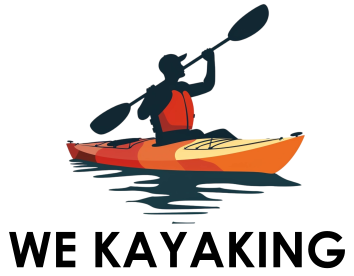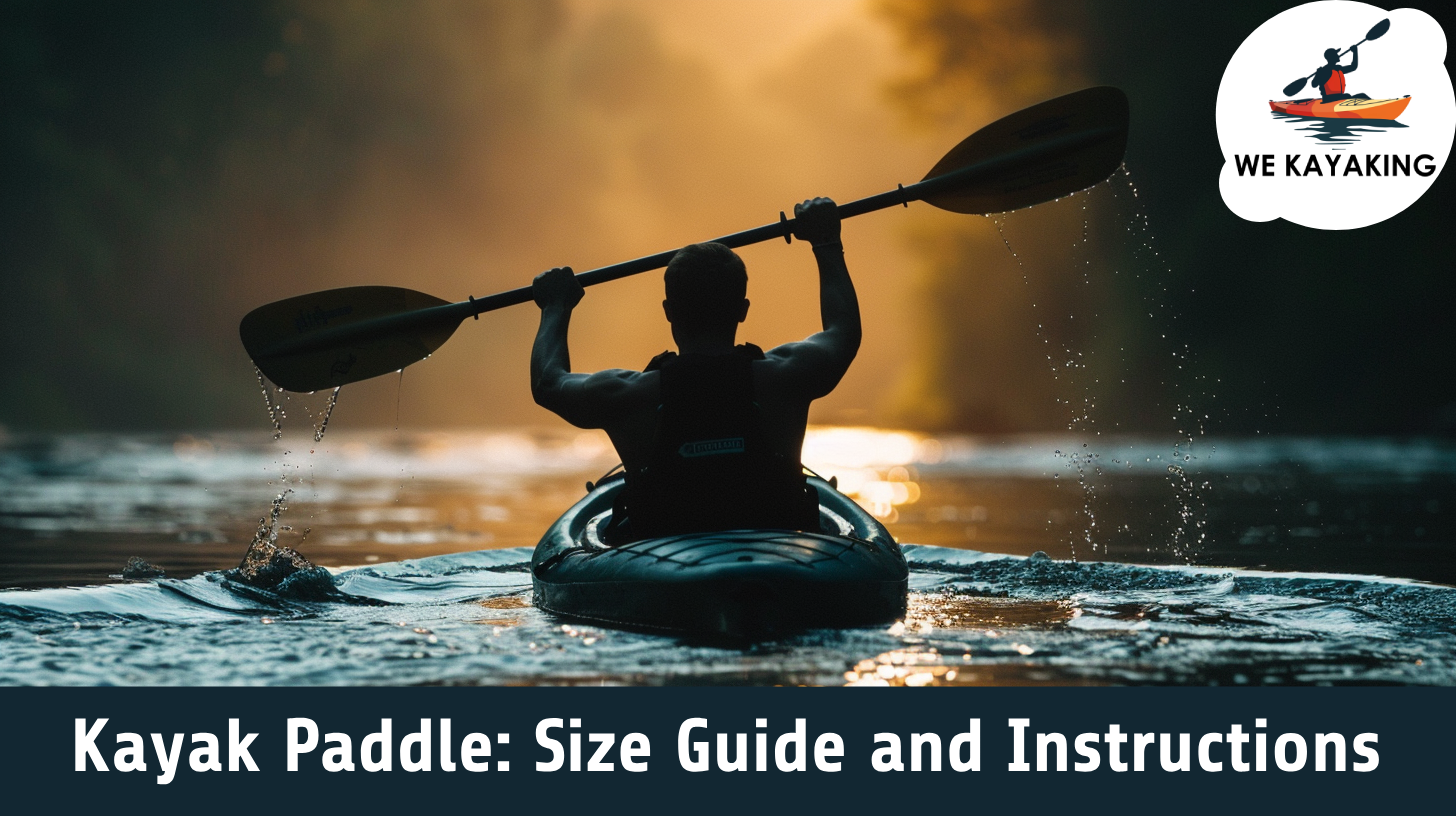
Kayak Paddle: Size Guide and Instructions
A kayak paddle is a tool used for propelling a kayak through the water. It consists of a shaft with blades on either end, designed for efficient paddling. When choosing a kayak paddle, it’s crucial to consider the correct size for optimal performance. The size guide takes into account the paddler’s height, kayak width, and paddling style.
The height of the paddler determines the paddle itself. For a low-angle paddling style, the paddle length is determined by adding 4-8 inches (10-20 centimeters) to the paddler’s height. For high-angle paddling, the added length is 8-12 inches (20-30 centimeters).
The kayak’s width is also something that impacts the structure of the paddles. Wider kayaks require longer paddles. As a guide, add 10 centimeters (4 inches) to the recommended paddle length for every 10 centimeters (4 inches) increase in kayak width.
High-angle paddling styles, where the paddler’s hands are closer to shoulder height, require a shorter paddle. Low-angle paddling, with hands closer to waist height, benefits from a slightly longer paddle.
Table of Contents
What is a kayak paddle?
A kayak paddle is a specialized type of oar used for propelling a kayak through the water. It is designed for paddlers to use in a rotational motion, pulling the water in a manner that propels the kayak forward. Kayak paddles come in various lengths, materials, and blade shapes, each offering different performance characteristics for different styles of kayaking.
The range for kayak paddle lengths is between 210 cm to 260cm (6.8 6.8-8.5 feet), with some variations outside of this range for specialized purposes. Recreational kayaks and paddlers with average height use paddles in the 220cm to 230cm (7.2-7.5 feet) range, while wider kayaks or paddlers with a more aggressive paddling style require longer paddles in the 240 cm to 260cm (7.4-8.5 feet) range. Additionally, whitewater kayaks and some specialized touring kayaks use shorter paddles, typically in the 190 cm to 210cm range, to accommodate the narrower width and different paddling techniques associated with these types of kayaking.
The weight of kayak paddles varies based on several factors, including the materials used in their construction and the design features. Aluminum paddles, though more affordable, tend to be heavier and are chosen by beginners or for recreational use. Aluminum paddles are heavy, with weights ranging from 1.5 to 2.5 pounds (0.7 to 1.1 kilograms). Fiberglass paddles strike a balance between weight and performance, making them popular among recreational and intermediate paddlers. Fiberglass paddles are lighter than aluminum, typically ranging from 1 to 2 pounds (0.45 to 0.9 kilograms). On the other hand, carbon fiber paddles are the lightest and preferred by advanced or competitive paddlers, albeit at a higher cost. Carbon fiber paddles are the lightest, weighing between 0.8 to 1.5 pounds (0.36 to 0.68 kilograms).
Kayak paddles come in a diverse array of colors, reflecting both the creative design choices of manufacturers and the personal preferences of paddlers. Classic black is a popular choice, offering a timeless and versatile look that complements various kayak styles. White paddles provide a clean and sleek appearance and enhance visibility in the water. Bright and vibrant colors, including red, blue, green, yellow, and orange, are common, adding a playful and personalized touch to the paddler’s gear.
What sizes of paddles exist?
Paddle sizes vary among the user and use case of the kayak. In terms of utility, these are the four types of paddles and sizes that exist.
- Recreational Paddles: Sizes range from 210 cm to 240 cm.
- Touring Paddles: Sizes range from 220 cm to 250 cm.
- Whitewater Paddles: Sizes range from 188 cm to 200 cm.
- Adjustable Paddles: Sizes range from 220 cm to 250 cm
Paddle sizes also vary among fellow kayakers. The following is a distinction based on the height of the kayaker.
- Persons under 5 feet (152 cm) are recommended to use a paddle length of 190 cm to 200 cm.
- Persons ranging from 5 feet to 5.5 feet (152 cm to 168 cm) are recommended to use a paddle length of 200 cm to 220 cm.
- Persons ranging from 5.5 feet to 6 feet (168 cm to 183 cm) are recommended to use a paddle length of 220 cm to 230 cm.
- Persons ranging from 6 feet and above (183 cm and above) are recommended to use a paddle length of 230 cm to 250 cm.
What does the size of the paddle affect?
The size of a kayak paddle affects the efficiency, comfort, and performance of paddling. It influences how well the paddler propels and controls the kayak, impacting factors such as stroke efficiency, reach, and maneuverability.
The size of the paddle directly affects stroke efficiency, determining how effectively each stroke propels the kayak through the water. Optimal paddle size enhances comfort by avoiding overreaching or uncomfortable strokes, minimizing fatigue, and ensuring a more enjoyable paddling experience.
Additionally, paddle size influences the paddler’s reach and control over the kayak, impacting maneuverability in different water conditions and influencing the paddler’s performance in the water. Considerations such as kayak width play a role in paddle selection, with wider kayaks requiring longer paddles for efficient reach.
Why are there different sizes of paddles?
There are different sizes of kayak paddles to cater to the diverse range of paddlers, kayaks, and paddling styles. Paddlers vary in height, kayaks come in different widths and designs, and the paddles’ paddling styles are different according to their situations, leading to a need for paddle customization.
Tailoring the paddle size to the individual’s height ensures optimal stroke mechanics and comfort. The width of the kayak and preferred paddling style also play roles in determining the appropriate paddle length. Different paddle sizes cater to various kayaking activities, from touring to whitewater, each demanding specific lengths for optimal performance.
How to choose a paddle?
To choose a paddle, you should consider your height, kayak width, and paddling style. Paddle length at its ideal level improves comfort and stroke efficiency.
Your height directly impacts the paddle length. Most manufacturers provide sizing charts to guide your selection. For instance, a known guideline is that for a paddler around 5 feet, a paddle length of approximately 220-230 cm is suitable, while someone who is 6 feet to 6 feet 5 inches prefers 230-240 cm.
Adjustments are needed based on your personal preferences and the width of your kayak. Wider kayaks require longer paddles for efficient reach, while narrower kayaks benefit from slightly shorter paddles.
The table below shows the criteria for choosing your paddle according to paddler height, kayak width, and utility.
| Paddler Height | Kayak Width | Recommended Paddle Length for Recreational Use | Recommended Paddle Length for Touring Use |
| 5.0 ft | 54 cm | 220.8 cm | 245.9 cm |
| 5.1 ft | 55 cm | 221.5 cm | 246.5 cm |
| 5.2 ft | 56 cm | 222.2 cm | 247.2 cm |
| 5.3 ft | 57 cm | 222.9 cm | 247.9 cm |
| 5.4 ft | 58 cm | 223.2 cm | 248.6 cm |
| 5.5 ft | 59 cm | 224.3 cm | 249.6 cm |
| 5.6 ft | 60 cm | 225.0 cm | 250.0 cm |
| 5.7 ft | 61 cm | 225.7 cm | 250.7 cm |
| 5.8 ft | 62 cm | 226.5 cm | 251.5 cm |
| 5.9 ft | 63 cm | 227.1 cm | 252.0 cm |
| 6.0 ft | 64 cm | 227.8 cm | 252.9 cm |
| 6.1 ft | 65 cm | 228.4 cm | 253.5 cm |
| 6.2 ft | 66 cm | 229.0 cm | 254.2 cm |
| 6.3 ft | 67 cm | 229.8 cm | 254.8 cm |
| 6.4 ft | 68 cm | 230.7 cm | 255.5 cm |
| 6.5 ft | 69 cm | 231.4 cm | 256.3 cm |
Some other tips to consider before choosing your paddle include: Being between sizes, it is better to go for the longer paddle. If the kayak has a higher seating position, having a shorter paddle is better. If you have a relaxed paddling style, a slightly longer kayak is preferable.
How to measure the size of a kayak paddle?
To measure a kayak paddle, both your height and the width of your kayak need to be taken into account. The size of a kayak paddle is measured from the tip of one blade to the tip of the other and is typically listed in centimeters. Taller individuals and wider kayaks require longer paddles, while shorter individuals and narrow kayaks require shorter paddles.
What size paddle for a 10ft kayak?
A standard paddle size for a 10ft kayak is 220-240 cm. This range considers the closer proximity of the paddler to the water and the reduced width of a 10ft kayak, accommodating a more efficient and comfortable paddling experience.
Do kayak paddles float?
Yes, kayak paddles do float. Kayak paddles are designed to float because of their materials and construction. They are commonly made from buoyant materials like plastic, fiberglass, or lightweight metals like aluminum for the shaft, all of which contribute to their ability to stay afloat longer. This feature is crucial for safety and convenience; it ensures that if the paddle is accidentally dropped into the water, it won’t sink to the bottom, making it retrievable and preventing you from being stranded without a paddle. However, how well a paddle floats varies depending on its design and the materials used, with some staying afloat better or longer than others.
What are the types of kayak paddles?
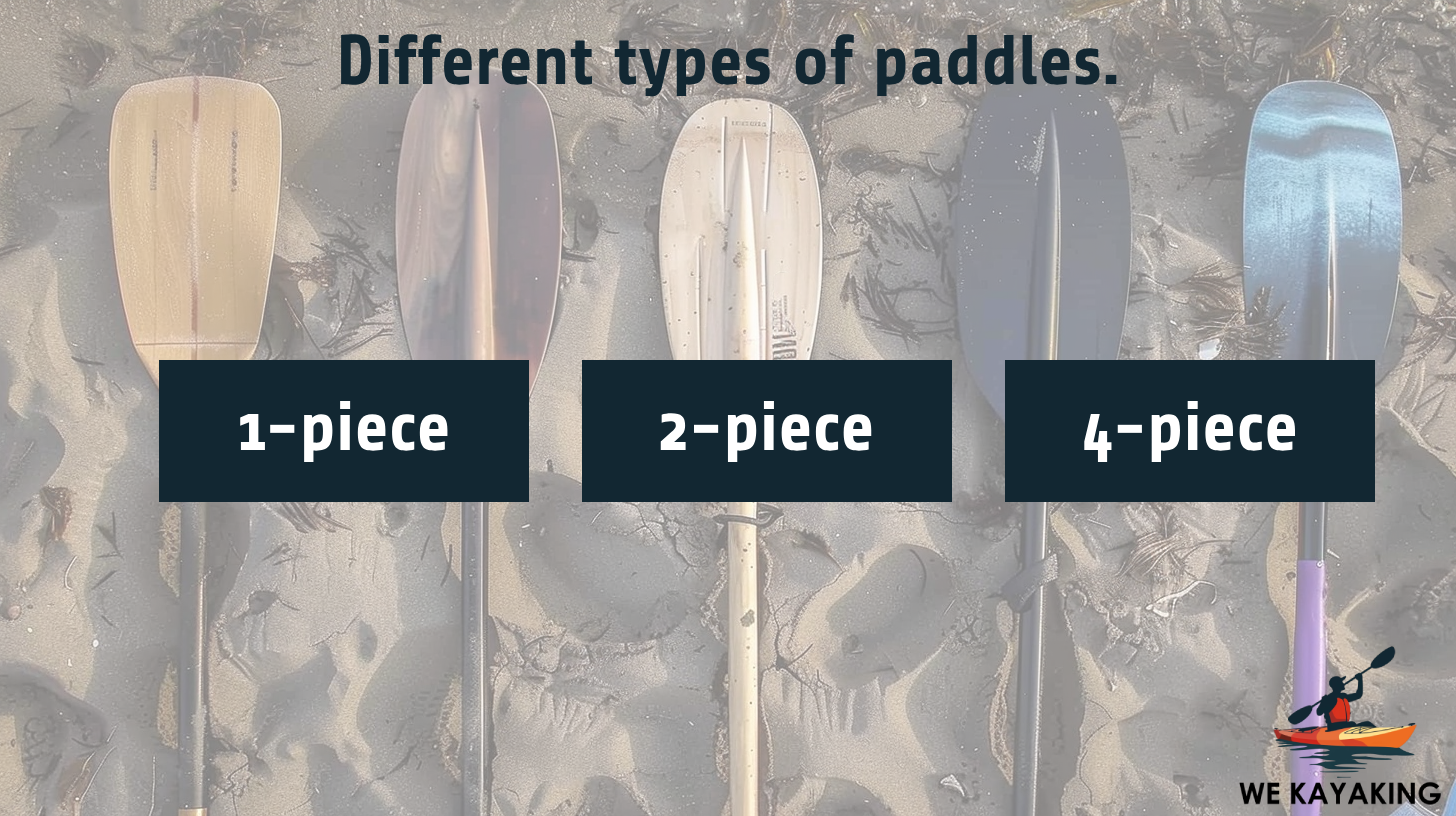 Kayak paddles are categorized by the number of pieces they are broken down into for storage and transport. The main types of kayak paddles are given below:
Kayak paddles are categorized by the number of pieces they are broken down into for storage and transport. The main types of kayak paddles are given below:
1-piece kayak paddles are a single and continuous unit that tends to be the strongest and most rigid type, offering optimal and consistent performance. Their utility is best administered by paddlers who prioritize performance and don’t need to break down their paddles for transport.
2-piece kayak paddles are paddles that are split into two sections. These paddles are popular among consumers as they strike a balance between convenience and performance. These paddles are for the everyday paddler who needs a practical, easy-to-carry option that still offers good performance.
4-piece kayak paddles break down into four sections, offering the ultimate in compact storage and transportability. Traveling paddlers, especially those who take trips where space is a premium, like backcountry kayaking or flying with gear.
What materials are paddles made of?
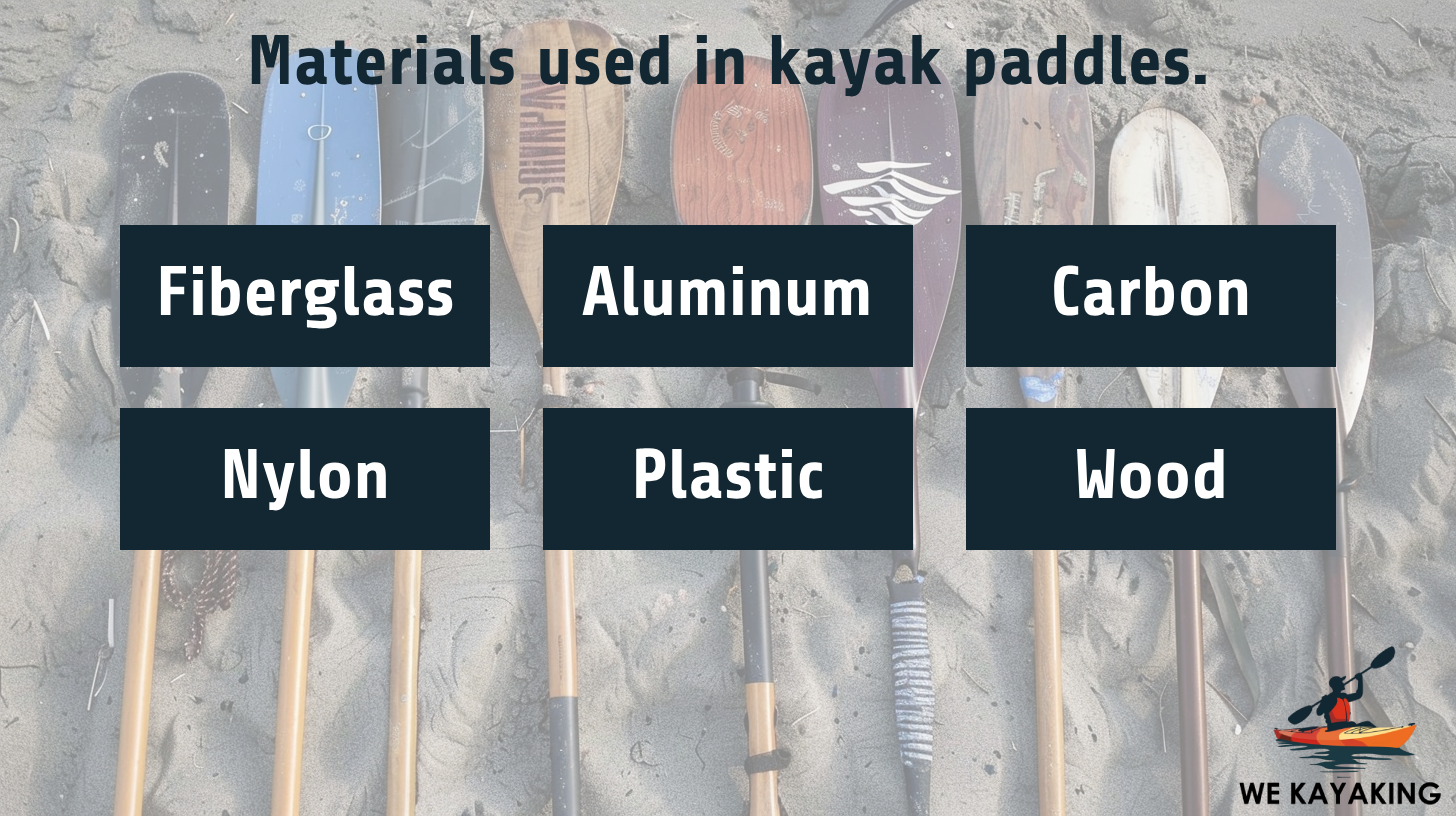 Kayak paddles are made from a variety of materials, each offering different benefits in terms of performance, weight, durability, and cost. These materials include aluminum, fiberglass, carbon fiber, plastic, or wood.
Kayak paddles are made from a variety of materials, each offering different benefits in terms of performance, weight, durability, and cost. These materials include aluminum, fiberglass, carbon fiber, plastic, or wood.
Aluminum kayak paddles are durable, affordable, and heavier than other materials. It’s used in recreational or beginner paddles. These paddles are best for paddlers who are looking for a sturdy and cost-effective option.
Fiberglass kayak paddles are lightweight, durable, and more expensive than aluminum. Fiberglass provides a good balance between weight and performance, and it is used in both shafts and blades. Regular paddlers who want a lighter paddle without the high cost of carbon fiber will go with this option.
Carbon fiber kayak paddles are the lightest and stiffest paddles on the market. It’s the material of choice for high-end, performance-oriented paddles but comes at a premium price. This is for professional paddlers who need the best performance and are willing to invest more.
Plastic kayak paddles are used for the blades in combination with aluminum shafts for entry-level paddles. It’s the most affordable, but also the heaviest and least durable. Casual or beginner paddlers are the ones who go for this budget-friendly option.
Wood kayak paddles Offer a traditional look and feel with excellent durability and a moderate weight. Wood paddles are aesthetically pleasing and are sometimes custom-made. These paddles are made for the paddler who appreciates the aesthetic and feel of wood and is looking for a durable, mid-weight paddle.
Are carbon fiber kayak paddles good?
Yes, carbon fiber kayak paddles are good due to their lightweight, strength, stiffness, and durability. I think carbon fiber kayak paddles are best for the professional paddler who takes kayaking seriously since these paddles reduce fatigue, allowing for longer and more efficient paddling. These kayak paddles are an overall good pick, but depending on their use case, their utility and worth do elevate.
Are aluminum kayak paddles good?
Yes, aluminum kayak paddles are good. They are known for their durability and affordability. While heavier than carbon fiber or fiberglass paddles, aluminum paddles are sturdy and withstand a lot of abuse. I think these paddles are best utilized by beginners and casuals who don’t kayak often.
Are plastic kayak paddles good?
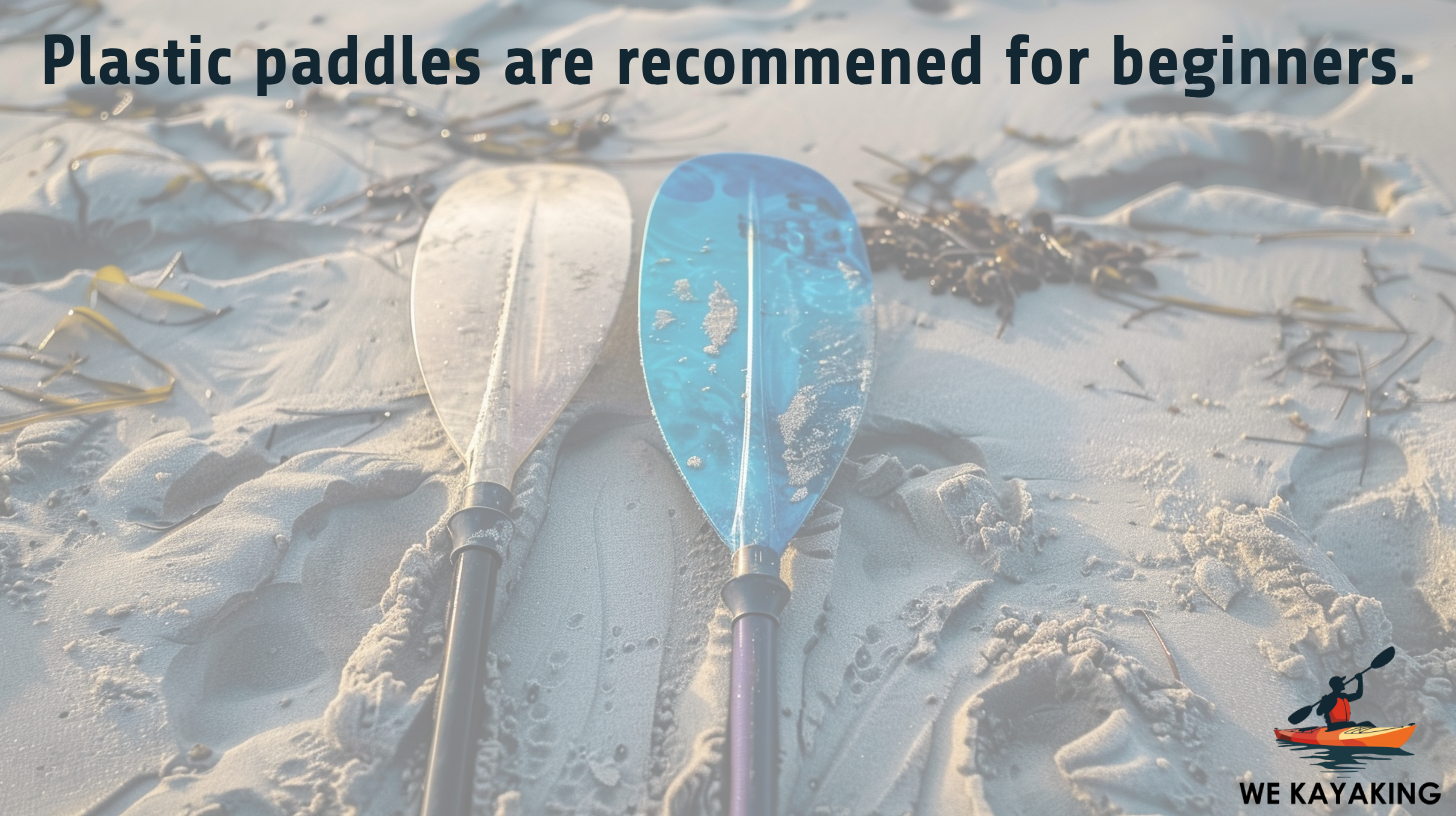 Yes, plastic kayak paddles are good, particularly for beginners or casual paddlers, due to their affordability and durability. Although they are less effective and heavier than paddles composed of materials like carbon fiber or fiberglass, they are still appropriate for use in rocky or shallow waters because of their high impact and wear resistance. I tried these paddles when starting out kayaking, as they were great for inexperienced paddlers to learn from. For those just starting out, plastic paddles are a completely viable and recommended option.
Yes, plastic kayak paddles are good, particularly for beginners or casual paddlers, due to their affordability and durability. Although they are less effective and heavier than paddles composed of materials like carbon fiber or fiberglass, they are still appropriate for use in rocky or shallow waters because of their high impact and wear resistance. I tried these paddles when starting out kayaking, as they were great for inexperienced paddlers to learn from. For those just starting out, plastic paddles are a completely viable and recommended option.
How much does a kayak paddle weigh?
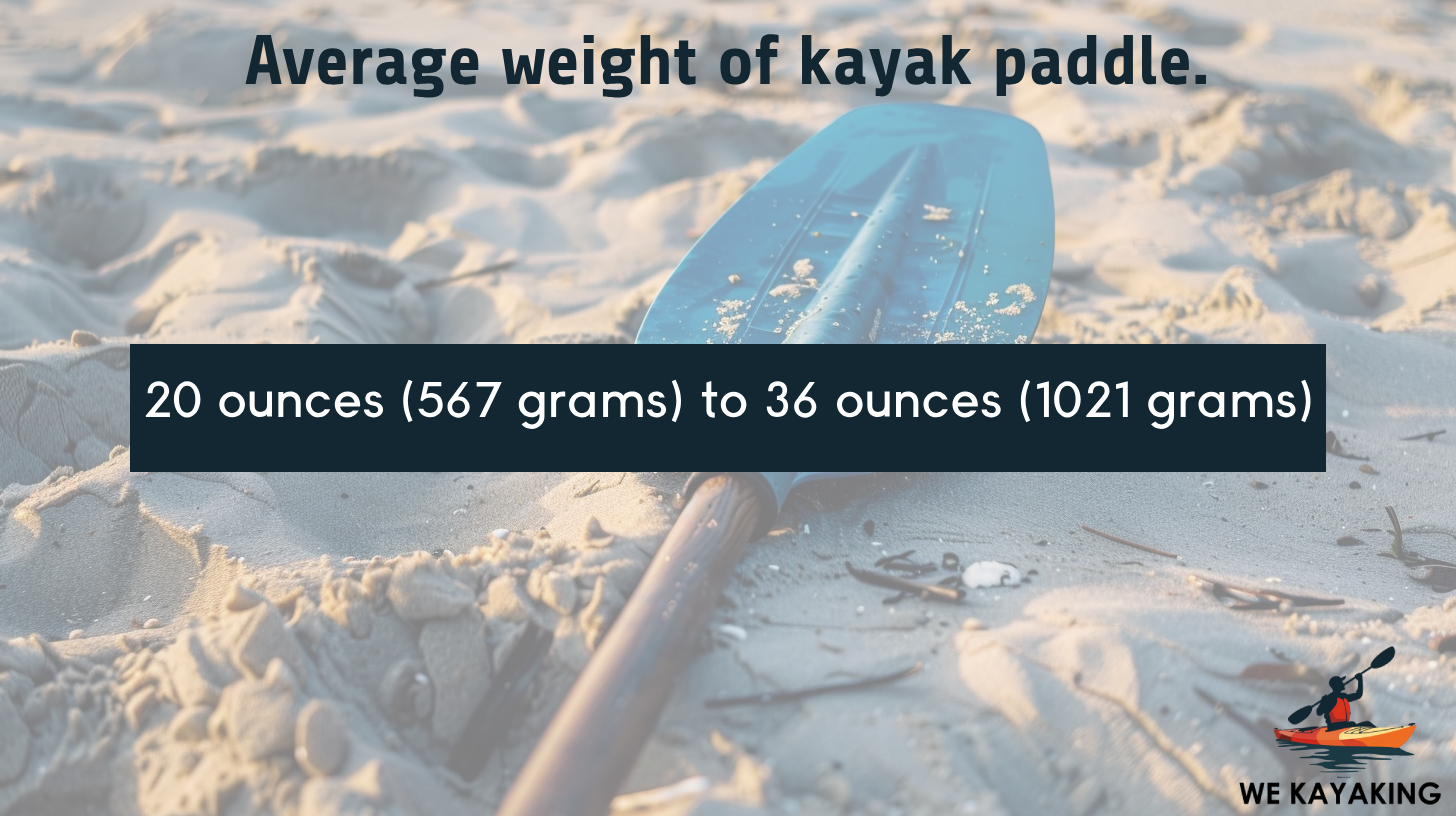 A good range for kayak paddle weight is between 20 ounces (567 grams) to 36 ounces (1021 grams). The lightest paddles, which weigh as little as 20 ounces and are composed of carbon fiber, are perfect for prolonging or intensifying paddling sessions by decreasing paddler fatigue and boosting performance.
A good range for kayak paddle weight is between 20 ounces (567 grams) to 36 ounces (1021 grams). The lightest paddles, which weigh as little as 20 ounces and are composed of carbon fiber, are perfect for prolonging or intensifying paddling sessions by decreasing paddler fatigue and boosting performance.
Fiberglass paddles offer a good balance between weight and performance, being slightly heavier than carbon fiber paddles and weighing between 24 and 30 ounces. On the heavier end, aluminum and plastic paddles weigh from 30 ounces up to 36 ounces. These are more durable and cost-effective but they lead to quicker fatigue due to their weight.
What is the optimal weight of a paddle?
The optimal weight of a kayak paddle for most users is 25 ounces (708 grams). This weight offers a good balance between lightness for ease of use and sufficient durability for various kayaking conditions. This weight class is favored by both recreational and more serious kayakers for its ability to provide a comfortable, efficient paddling experience.
How does the paddle affect the speed of the kayak?
A kayak’s speed is influenced by the design and functionality of its paddle. A larger blade affects a larger mass of water and thus does not move through the water as fast. They provide immediate power and are preferred by those needing quick acceleration or paddling in fast-moving water.
Smaller blades, however, are easier to move through the water, allowing for higher stroke rates and potentially greater overall speed over long distances as they conserve the paddler’s energy.
How does a paddle affect the maneuverability of a kayak?
A kayak paddle directly affects the maneuverability of the kayak through various aspects such as blade shape, size, and the paddler’s technique. High-angle blades are wider and shorter for aggressive strokes, enhancing quick and responsive maneuvers, while low-angle blades are longer and narrower, suitable for smooth and sustained turns.
Smaller blades are better for subtle direction changes and are less taxing over extended distances, while larger blades provide greater power for instantaneous control, which is advantageous in quick maneuvers.
Another factor is paddle length; longer paddles enable wider turns, while shorter paddles enable sharper, faster turns. The weight and material of the paddle impact its responsiveness, with lighter paddles aiding rapid movement and heavier ones providing steadier control.
How does a paddle affect the safety of a person in a kayak?
The paddle plays a crucial role in a kayaker’s safety as it offers necessary control, stability, and maneuverability. It allows kayakers to steer accurately, avoid obstacles, and respond promptly to changing conditions, which is crucial in preventing capsizes or collisions. In choppy waters, bracing with the paddle is one way to improve stability and avoid tipping. To prevent fatigue and reach safety promptly in an emergency, the kayaker must be able to maintain speed and endurance, which is ensured by a lightweight, effective paddle.
How to use a kayak paddle?
Start by gripping the paddle with both hands approximately shoulder-width apart. Position the paddle horizontally over the kayak, aligning the blades so they are in line with each other. Begin by dipping one blade into the water near the side of the kayak, immersing it fully for a more effective stroke.
In the process of learning how to paddle, use both arm and torso rotation for maximum strength and efficiency. Pull the blade back through the water toward the back of the kayak as it cuts through. To increase the force of your stroke, simultaneously push forward with the opposing hand. As you complete the stroke, lift the blade out of the water at your hip and smoothly transition to the opposite side, repeating the motion to maintain momentum.
